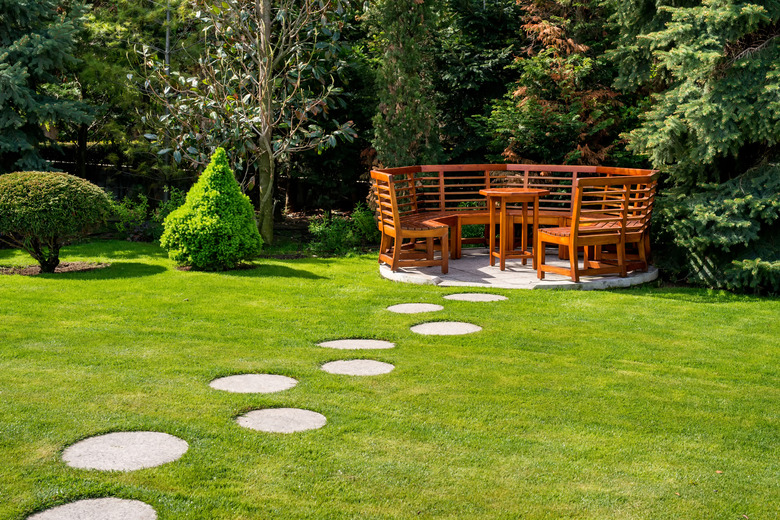How To Dethatch A Lawn: A DIY Guide
If your lawn is looking worse for the wear, it may be time for dethatching, and the choice of a dethatcher depends on the size of the lawn and the thickness of the thatch layer. You can make removal of the thatch layer a weekend DIY project and use a thatching rake, which works fine for small lawns even if the thatch buildup is extensive. A power dethatcher is recommended for large lawns because manual dethatching is extremely labor intensive, and your choices include a cordless or corded dethatcher or a power rake, which is a somewhat more heavy-duty tool for deeply thatched lawns.
When to Dethatch Your Lawn
Thatch is that layer of dead grass mixed with dead and living grass roots and stems that collects at the base of the grass blades, and it isn't always problematic. In fact, when the layer is less than 1/2 inch thick, it acts as mulch and benefits the grass by insulating the roots and retaining moisture in the soil. Thatch becomes problematic, however, when the layer exceeds 1/2 inch in thickness because then it blocks water and nutrients from getting to the soil, and it promotes fungal and bacterial growth that can harm the grass. If your grass is chronically brown and ragged despite all your best lawn care efforts, the thatch buildup is probably too thick.
Dethatching is stressful for the lawn, so the best time to do it is in the part of the growing season during which the grass is most likely to recover quickly. Cool-season grasses such as Kentucky bluegrass, perennial ryegrass and tall fescue should be dethatched in early spring or early fall. Warm-season grasses like Bermuda grass, St. Augustine grass and zoysia grass should be dethatched in the late spring or early summer.
Manually Dethatching With a Rake
A dethatching rake has two different sets of tines on opposite sides of the rake head, and it's important to know what they are for, or you could end up damaging the lawn. The tines on both sides are triangular and are made of steel, and they are closer together than the tines on a standard rake, but those on one side of the rake head are straight, and the ones on the other side are curved. You want to loosen the thatch with the straight tines; the curved ones are for removing the thatch.
If the rake has an adjustable head, set it at a low angle relative to the ground so that the rake glides over the soil surface rather than digging into it. Pull the rake toward you and push it in the opposite direction to separate as much dead grass as possible from an area of a few square feet and then shake off the thatch into a pile and move to another section of the lawn. When you're done, rake the thatch pile with a leaf rake and throw it on your compost pile.
Dethatching an entire lawn by raking is a project that can easily take an entire day depending on the size of the lawn. The job is a little easier if you mow the lawn first, setting the height of the lawn mower to half the normal height of the grass.
Dethatching With a Corded Dethatcher
A corded dethatcher is a tool that every homeowner should have in the shed, and using it at least once a year helps maintain a healthy lawn and prevents many of the problems that a thick layer of thatch can cause. You simply run it over the lawn in the same way you would use a lawn mower, and some lawn mowers come equipped with a dethatcher so you can dethatch while mowing. It separates the thatch and deposits it onto the surface of the lawn, where you can remove it with a leaf rake. If you're assiduous about doing this regularly, you should be able to remove most of the thatch in a single pass, and the thatch that remains will provide a thin mulch layer that will help to keep the lawn healthy.
Dethatching With a Power Rake
If it has been several years since you've dethatched the lawn and the grass appears to be struggling, you need a more heavy-duty machine, especially if you have a large lawn. A power rake is a gas-powered yard tool that has rotating tines similar to those of a corded dethatcher, but it's capable of removing four times as much thatch in a single pass. Even so, you may have to make several passes with the machine, raking up the dead grass between passes to completely remove all the thatch from a lawn that has been neglected.
Because a power rake is a heavy-duty tool that you use only occasionally, you may want to rent one rather than buying one and having it sit unused for years in your tool shed. Some power rakes come with an automatic seed spreader for overseeding a distressed lawn at the same time that you dethatch it. As with manual dethatching, mowing the lawn to half its normal height before using a power rake minimizes damage to the lawn and is recommended.
Aerating, Reseeding, and Fertilizing
If a lawn has been neglected long enough, it's going to need more than dethatching to restore it. A thick thatch of grass clippings can smother the roots. It can also prevent moisture from reaching the roots, and the soil can get compacted, which helps contribute to signs of a lawn in distress, including browning, thinning and bare spots. If you find it difficult to push a screwdriver into the soil, you'll probably want to aerate the soil after you dethatch or even instead of dethatching if the thatch layer isn't very thick.
Aerating, which involves removing plugs of soil to loosen it and allow oxygen to circulate, can be accomplished with a rolling core aerator or plug aerator. Avoid walking over the lawn with spiked lawn aerator shoes, because spikes can actually compact the soil even more. The ground should be moist, but not overly wet, when you use an aerator.
Reseeding will be necessary if the lawn has thinned excessively or if there are many bare spots. Your dethatcher may include a seed spreader so you can spread new seed while you dethatch, or you can spread seed manually on bare spots or use a handheld seed spreader or a rolling one to cover the entire lawn. Finish by feeding the lawn with a high-nitrogen lawn fertilizer and then water it well. When you're done, the lawn will look like it has undergone a major operation — because it has — but it should recover quickly and be more lush and green and much healthier than it was before.


